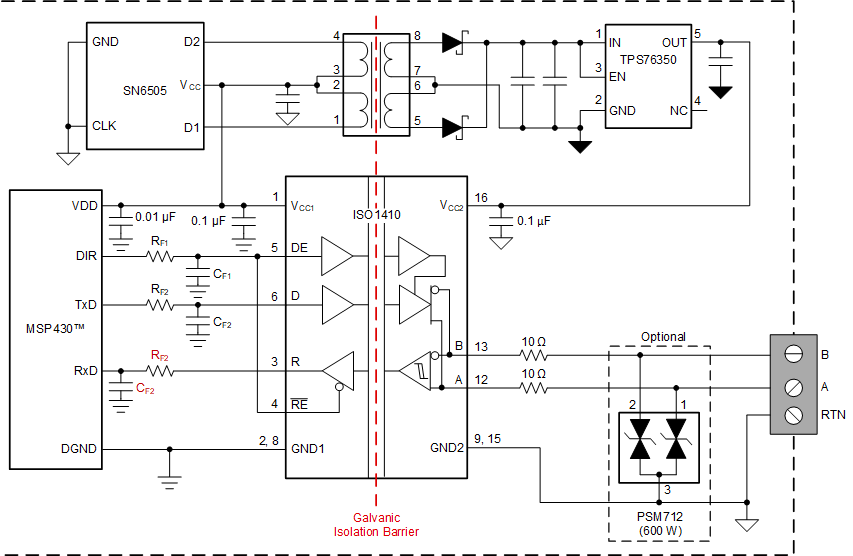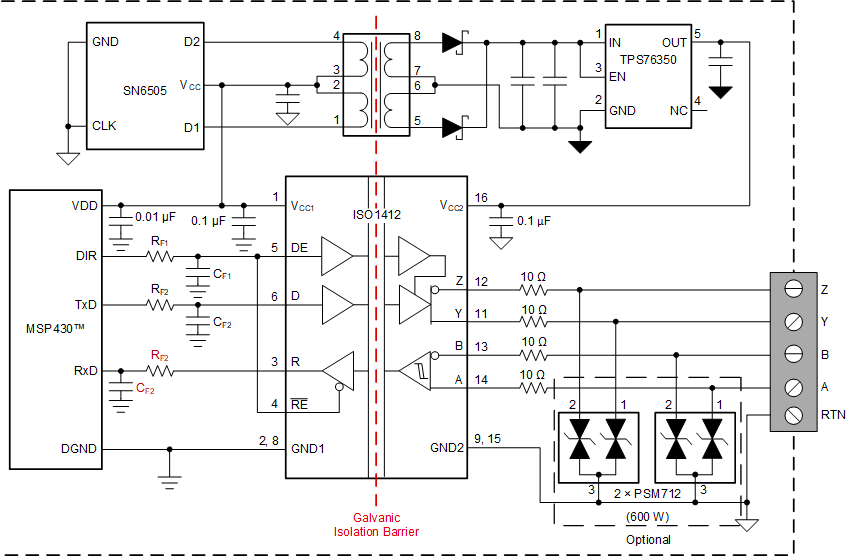SLLA453A May 2019 – September 2022 ISO1176 , ISO1410 , ISO1412 , ISO1430 , ISO1432 , ISO1450 , ISO1452 , ISO15 , ISO1500 , ISO3080 , ISO3082 , ISO3086 , ISO3088 , ISO35 , SN6501
1 Design
All ISO14xx and ISO1500 transceivers use TI's SiO2 based isolation technology to provide reliable high voltage isolation for the RS-485 transmit, receive, and enable signals. The ISO14xx family is Profibus compliant to support a larger differential voltage at 5-V bus-side supply to ensure reliable communication in noisy industrial environments. The ISO1500 is a small solution size option with lowered isolation specifications, ideal for isolating ground loops in long distance communication. The wide primary side supply voltage of ISO14xx and ISO1500 provide the option to interface directly with low-voltage microcontrollers to conserve power, whereas the 5 V option on the secondary side maintains a high signal-to-noise ratio of the bus signals. These transceivers all present 1/8 unit load to the bus for support of up to 256 nodes and have a typical common mode transient immunity of 100 kV/us.
The push-pull transformer driver SN6505B paired with an external transformer and optional rectifying LDO create an isolated power supply to power the isolated transceiver. The SN6505B device allows a maximum of 5 W of power to systems that need isolated power for multiple devices and alternatively SN6501 can be used for up to 1.5 W of output power. This solution provides a compact, efficient, and low noise solution for creating an isolated power supply.
The ISO14xx family has robust EMC protection integrated into the device capable of 30 kV HBM ESD, 16 kV IEC ESD, and 4 kV IEC EFT. To further enhance the transient protection, a low-capacitive transient voltage suppressor (TVS), such as PSM712, is optional. The device provides a 600 W surge capability, 75 pF of capacitance, and up to 40 kV ESD protection, while its stand-off voltages cover the RS-485 common-mode range of –7 V to +12 V. Implementation of additional noise filtering to the signal paths between the node controller and the single-ended side of the transceiver through simple R-C low-pass filters is recommended. Calculate the filter component values such that RF × CF = 0.032 / fS with fS being the highest signal frequency of interest.
Figure 1-1 shows the system diagram for a half-duplex isolated RS-485 node using ISO1410 for signal isolation and SN6505B with transformer for power isolation. Figure 1-2 shows the system diagram for a full-duplex isolated RS-485 node using ISO1412 for signal isolation and SN6505B with transformer for power isolation.
 Figure 1-1 Half-duplex Isolated RS-485 Node
Figure 1-1 Half-duplex Isolated RS-485 Node Figure 1-2 Full-duplex Isolated RS-485 Node
Figure 1-2 Full-duplex Isolated RS-485 Node